Study on the Thermal Radiation Characteristics of Tungsten Surface Grating Structures Prepared by Femtosecond Laser Direct Writing
Abstract
:1. Introduction
2. Materials and Methods
2.1. Preparation and Characterization of Micro–Nano Structure
2.2. Simulation Method and Model Design
3. Results and Discussion
3.1. The Influence of Varying Laser Fluence on the Grating Structure
3.2. The Influence of Different Grating Structures on the Thermal Radiation Spectrum
3.3. The Effect of Varying Heating Temperatures on the Thermal Radiation Spectrum
4. Conclusions
Author Contributions
Funding
Institutional Review Board Statement
Informed Consent Statement
Data Availability Statement
Acknowledgments
Conflicts of Interest
Appendix A
References
- Modest, M.F.; Mazumder, S. Radiative Heat Transfer; Academic Press: Cambridge, MA, USA, 2021. [Google Scholar]
- Gray, W.A.; Müller, R. Engineering Calculations in Radiative Heat Transfer: International Series on Materials Science and Technology; Elsevier: Amsterdam, The Netherlands, 2013; Volume 13. [Google Scholar]
- Li, W.; Fan, S.H. Nanophotonic control of thermal radiation for energy applications [Invited]. Opt. Express 2018, 26, 15995–16021. [Google Scholar] [CrossRef] [PubMed]
- Coutts, T.J. An overview of thermophotovoltaic generation of electricity. Sol. Energy Mater. Sol. Cells 2001, 66, 443–452. [Google Scholar] [CrossRef]
- Inoue, T.; De Zoysa, M.; Asano, T.; Noda, S. Realization of dynamic thermal emission control. Nat. Mater. 2014, 13, 928–931. [Google Scholar] [CrossRef] [PubMed]
- Zhang, X.S.; Chen, Y.J.; Hu, J.L. Recent advances in the development of aerospace materials. Prog. Aerosp. Sci. 2018, 97, 22–34. [Google Scholar] [CrossRef]
- Tian, J.L.; Zhang, W.; Gu, J.J.; Deng, T.; Zhang, D. Bioinspired Au-CuS coupled photothermal materials: Enhanced infrared absorption and photothermal conversion from butterfly wings. Nano Energy 2015, 17, 52–62. [Google Scholar] [CrossRef]
- Lenert, A.; Bierman, D.M.; Nam, Y.; Chan, W.R.; Celanovic, I.; Soljacic, M.; Wang, E.N. A nanophotonic solar thermophotovoltaic device. Nat. Nanotechnol. 2014, 9, 126–130. [Google Scholar] [CrossRef]
- Zhao, B.; Santhanam, P.; Chen, K.F.; Buddhiraju, S.; Fan, S.H. Near-Field Thermophotonic Systems for Low-Grade Waste-Heat Recovery. Nano Lett. 2018, 18, 5224–5230. [Google Scholar] [CrossRef] [PubMed]
- Wang, Z.L.; Zhang, Z.M.; Quan, X.J.; Cheng, P. A perfect absorber design using a natural hyperbolic material for harvesting solar energy. Sol. Energy 2018, 159, 329–336. [Google Scholar] [CrossRef]
- Molesky, S.; Jacob, Z. Ideal near-field thermophotovoltaic cells. Phys. Rev. B 2015, 91, 205435. [Google Scholar] [CrossRef]
- Navarro-Baena, I.; Jacobo-Martín, A.; Hernández, J.J.; Smirnov, J.R.C.; Viela, F.; Monclús, M.A.; Osorio, M.R.; Molina-Aldareguia, J.M.; Rodríguez, I. Single-imprint moth-eye anti-reflective and self-cleaning film with enhanced resistance. Nanoscale 2018, 10, 15496–15504. [Google Scholar] [CrossRef] [PubMed]
- Huang, Z.J.; Shi, X.Y.; Wang, G.; Leukkunen, P.; Huttula, M.; Cao, W. Antireflective design of Si-based photovoltaics via biomimicking structures on black butterfly scales. Solar Energy 2020, 204, 738–747. [Google Scholar] [CrossRef]
- Liu, Y.; Song, Y.Y.; Niu, S.C.; Zhang, Y.L.; Han, Z.W.; Ren, L.Q. Integrated super-hydrophobic and antireflective PDMS bio-templated from nano-conical structures of cicada wings. RSC Adv. 2016, 6, 108974–108980. [Google Scholar] [CrossRef]
- Fan, S.H. Thermal Photonics and Energy Applications. Joule 2017, 1, 264–273. [Google Scholar] [CrossRef]
- Liu, S.; Song, H.Y.; Wang, S.N.; Du, B.R.; Wang, B.; Emara, E.M.; Liu, S.B. Surface micro-nano hydrophobic structuring on silver-coated semiconductor substrate by femtosecond laser irradiation. J. Laser Appl. 2022, 34, 012019. [Google Scholar] [CrossRef]
- Zhang, Z.Y.; Gu, Q.M.; Jiang, W.; Zhu, H.; Xu, K.; Ren, Y.P.; Xu, C. Achieving of bionic super-hydrophobicity by electrodepositing nano-Ni-pyramids on the picosecond laser-ablated micro-Cu-cone surface. Surf. Coat. Technol. 2019, 363, 170–178. [Google Scholar] [CrossRef]
- Yang, G.F.; Zhang, H.; Li, H.W.; Lu, M.K.; Zhai, W.; Cui, J. Experimental study on the ice suppression characteristics of TC4 microstructure surface induced by femtosecond pulsed laser. Surf. Coat. Technol. 2021, 405, 126558. [Google Scholar] [CrossRef]
- Langevin, D.; Verlhac, C.; Jaeck, J.; Abou-Hamdan, L.; Taupeau, E.; Fix, B.; Bardou, N.; Dupuis, C.; De Wilde, Y.; Haidar, R.; et al. Experimental Investigation of the Thermal Emission Cross Section of Nanoresonators Using Hierarchical Poisson-Disk Distributions. Phys. Rev. Lett. 2024, 132, 043801. [Google Scholar] [CrossRef] [PubMed]
- De Zoysa, M.; Asano, T.; Mochizuki, K.; Oskooi, A.; Inoue, T.; Noda, S. Conversion of broadband to narrowband thermal emission through energy recycling. Nat. Photonics 2012, 6, 535–539. [Google Scholar] [CrossRef]
- Ma, X.R.; Du, B.R.; Tan, S.W.; Song, H.Y.; Liu, S.B. Spectral Characteristics Simulation of Topological Micro-Nano Structures Based on Finite Difference Time Domain Method. Nanomaterials 2021, 11, 2622. [Google Scholar] [CrossRef] [PubMed]
- Guo, X.J.; Song, H.Y.; Du, B.R.; Tan, S.W.; Liu, S.B. Study on Spectral Selective Manipulation Characteristics of Surface Multilevel Micro-Nano Structures by FDTD Simulation. Int. J. Mol. Sci. 2022, 23, 2774. [Google Scholar] [CrossRef] [PubMed]
- Arpin, K.A.; Losego, M.D.; Cloud, A.N.; Ning, H.L.; Mallek, J.; Sergeant, N.P.; Zhu, L.X.; Yu, Z.F.; Kalanyan, B.; Parsons, G.N.; et al. Three-dimensional self-assembled photonic crystals with high temperature stability for thermal emission modification. Nat. Commun. 2013, 4, 2630. [Google Scholar] [CrossRef]
- Chan, D.L.C.; Soljacic, M.; Joannopoulos, J.D. Thermal emission and design in 2D-periodic metallic photonic crystal slabs. Opt. Express 2006, 14, 8785–8796. [Google Scholar] [CrossRef] [PubMed]
- Yokoyama, T.; Dao, T.D.; Chen, K.; Ishii, S.; Sugavaneshwar, R.P.; Kitajima, M.; Nagao, T. Spectrally Selective Mid-Infrared Thermal Emission from Molybdenum Plasmonic Metamaterial Operated up to 1000 °C. Adv. Opt. Mater. 2016, 4, 1987–1992. [Google Scholar] [CrossRef]
- Coppens, Z.J.; Valentine, J.G. Spatial and Temporal Modulation of Thermal Emission. Adv. Mater. 2017, 29, 1701275. [Google Scholar] [CrossRef] [PubMed]
- Jin, W.L.; Polimeridis, A.G.; Rodriguez, A.W. Temperature control of thermal radiation from composite bodies. Phys. Rev. B 2016, 93, 121403. [Google Scholar] [CrossRef]
- Liu, B.A.; Gong, W.; Yu, B.W.; Li, P.F.; Shen, S. Perfect Thermal Emission by Nanoscale Transmission Line Resonators. Nano Lett. 2017, 17, 666–672. [Google Scholar] [CrossRef]
- Li, J. Thermal Radiation from Nanophotonic Structures: Theory, Numerical Simulation and Applications. Ph.D. Thesis, Carnegie Mellon University, Pittsburgh, PA, USA, 2020. Available online: https://www.proquest.com/dissertations-theses/thermal-radiation-nanophotonic-structures-theory/docview/2457933729/se-2 (accessed on 15 August 2024).
- Yu, H.Y.; Zhang, H.C.; Wang, H.M.; Zhang, D. The Equivalent Thermal Conductivity of the Micro/Nano Scaled Periodic Cubic Frame Silver and Its Thermal Radiation Mechanism Analysis. Energies 2021, 14, 4158. [Google Scholar] [CrossRef]
- Bikbaev, R.G.; Vetrov, S.Y.; Timofeev, I.V. Hybrid Tamm and surface plasmon polaritons in resonant photonic structure. J. Quant. Spectrosc. Radiat. Transf. 2020, 253, 107156. [Google Scholar] [CrossRef]
- Ge, C.X.; Wu, Z.S.; Bai, J.; Gong, L. Effect of nanoscale roughness on optical trapping properties of surface plasmon polaritons exerted on nanoparticle. J. Quant. Spectrosc. Radiat. Transf. 2018, 219, 339–349. [Google Scholar] [CrossRef]
- Wang, Q.; Yuan, G.H.; Kiang, K.S.; Sun, K.; Gholipour, B.; Rogers, E.T.F.; Huang, K.; Ang, S.S.; Zheludev, N.I.; Teng, J.H. Reconfigurable phase-change photomask for grayscale photolithography. Appl. Phys. Lett. 2017, 110, 201110. [Google Scholar] [CrossRef]
- Sai, H.; Yugami, H. Thermophotovoltaic generation with selective radiators based on tungsten surface gratings. Appl. Phys. Lett. 2004, 85, 3399–3401. [Google Scholar] [CrossRef]
- Sai, H.; Yugami, H.; Kanamori, Y.; Hane, K. Spectrally selective thermal radiators and absorbers with periodic microstructured surface for high-temperature applications. Microscale Thermophys. Eng. 2003, 7, 101–115. [Google Scholar] [CrossRef]
- Mason, J.A.; Adams, D.C.; Johnson, Z.; Smith, S.; Davis, A.W.; Wasserman, D. Selective thermal emission from patterned steel. Opt. Express 2010, 18, 25192–25198. [Google Scholar] [CrossRef] [PubMed]
- Mason, J.A. Selective Thermal Emission and Absorption from Mid-IR Resonators and Metamaterials. Ph.D. Thesis, University of Massachusetts Lowell, Lowell, MA, USA, 2012. Available online: https://www.proquest.com/dissertations-theses/selective-thermal-emission-absorption-mid-ir/docview/1020571465/se-2 (accessed on 15 August 2024).
- Jiao, S.H.; Zhao, K.; Jiang, J.H.; Zhao, K.L.; Guo, Q.; Wang, J.B.; Zhang, Y.S.; Chen, G.; Cheng, Q.; Zuo, P.; et al. Metasurface with all-optical tunability for spatially-resolved and multilevel thermal radiation. Nanophotonics 2024, 13, 1645–1655. [Google Scholar] [CrossRef]
- Shirk, M.D.; Molian, P.A. A review of ultrashort pulsed laser ablation of materials. J. Laser Appl. 1998, 10, 18–28. [Google Scholar] [CrossRef]
- Bragheri, F.; Paiè, P.; Vázquez, R.M. Editorial for the Special Issue on New Trends and Applications in Femtosecond Laser Micromachining. Micromachines 2022, 13, 150. [Google Scholar] [CrossRef] [PubMed]
- Butkute, A.; Jonusauskas, L. 3D Manufacturing of Glass Microstructures Using Femtosecond Laser. Micromachines 2021, 12, 499. [Google Scholar] [CrossRef]
- He, J.; Xu, B.J.; Xu, X.Z.; Liao, C.R.; Wang, Y.P. Review of Femtosecond-Laser-Inscribed Fiber Bragg Gratings: Fabrication Technologies and Sensing Applications. Photonic Sens. 2021, 11, 203–226. [Google Scholar] [CrossRef]
- Yan, M.F.; Li, R.; Li, M.; Liu, S.J.; Zhou, G.; Lin, C.G.; Dai, S.X.; Song, B.N.; Zhang, W.; Xu, T.F.; et al. Fabrication of multi-focal chalcogenide glass microlens arrays based on femtosecond laser-assisted chemical etching method. Opt. Laser Technol. 2024, 174, 110601. [Google Scholar] [CrossRef]
- Yao, H.; Pugliese, D.; Lancry, M.; Dai, Y. Ultrafast Laser Direct Writing Nanogratings and their Engineering in Transparent Materials. Laser Photon. Rev. 2024, 2300891. [Google Scholar] [CrossRef]
- Li, Q.S.; Shi, H.S.; Xi, S.M.; Xu, Z.H.; Zhang, L.; Liu, Y. Femtosecond-Laser Direct-Writing Hydrogel-Based Microlens Arrays Customized with Multi-Dimensional Optical Configurations for Information Encryption. Adv. Mater. Technol. 2024, 9, 2301923. [Google Scholar] [CrossRef]
- Gupta, M.S.; Ameen, E.; Veeraragavan, A.; Pesala, B. Design and fabrication of grating-based filters for micro-thermophotovoltaic systems. In Proceedings of the 7th International Conference on Advances in Energy Research, Mumbai, India, 10–12 December 2019; Springer: Singapore, 2021; pp. 1113–1119. [Google Scholar] [CrossRef]
- Kang, Q.; Guo, K.; Zhang, X.; Wang, W.; Guo, Z. Dynamically manipulating long-wave infrared polarized thermal radiation by a vanadium dioxide metasurface. Opt. Lett. 2024, 49, 2485–2488. [Google Scholar] [CrossRef] [PubMed]
- Chu, Q.Q.; Zhong, F.; Shang, X.H.; Zhang, Y.; Zhu, S.N.; Liu, H. Controlling thermal emission with metasurfaces and its applications. Nanophotonics 2024, 13, 1279–1301. [Google Scholar] [CrossRef]
- Lin, C.J.; Li, Y.; Chi, C.; Kwon, Y.S.; Huang, J.Y.; Wu, Z.X.; Zheng, J.Z.; Liu, G.Z.; Tso, C.Y.; Chao, C.Y.H.; et al. A Solution-Processed Inorganic Emitter with High Spectral Selectivity for Efficient Subambient Radiative Cooling in Hot Humid Climates. Adv. Mater. 2022, 34, 2109350. [Google Scholar] [CrossRef] [PubMed]
- Abbas, M.A.; Kim, J.; Rana, A.S.; Kim, I.; Rehman, B.; Ahmad, Z.; Massoud, Y.; Seong, J.; Badloe, T.; Park, K.; et al. Nanostructured chromium-based broadband absorbers and emitters to realize thermally stable solar thermophotovoltaic systems. Nanoscale 2022, 14, 6425–6436. [Google Scholar] [CrossRef] [PubMed]
- Zhang, J.G.; Wen, Z.J.; Zhou, Z.J.; Zhou, D.J.; Qiu, Q.L.; Ge, J.; Zeng, Y.X.; Sun, Y.; Zhou, L.; Dai, N.; et al. Long-wavelength infrared selective emitter for thermal infrared camouflage under a hot environment. Opt. Express 2022, 30, 24132–24144. [Google Scholar] [CrossRef] [PubMed]
- Seo, M.; Wang, K.; Echols, J.R.; Winfrey, A.L. Microstructure deformation and near-pore environment of resolidified tungsten in high heat flux conditions. J. Nucl. Mater. 2022, 565, 153725. [Google Scholar] [CrossRef]
- Morcos, P.; Elwany, A.; Karaman, I.; Arróyave, R. Review: Additive manufacturing of pure tungsten and tungsten-based alloys. J. Mater. Sci. 2022, 57, 9769–9806. [Google Scholar] [CrossRef]
- Liu, X.L.; Tyler, T.; Starr, T.; Starr, A.F.; Jokerst, N.M.; Padilla, W.J. Taming the Blackbody with Infrared Metamaterials as Selective Thermal Emitters. Phys. Rev. Lett. 2011, 107, 045901. [Google Scholar] [CrossRef] [PubMed]
- Zhong, F.; Ding, K.; Zhang, Y.; Zhu, S.; Chan, C.T.; Liu, H. Angle-Resolved Thermal Emission Spectroscopy Characterization of Non-Hermitian Metacrystals. Phys. Rev. Appl. 2020, 13, 014071. [Google Scholar] [CrossRef]
- Yang, Y.; Yang, J.; Liang, C.; Wang, H.; Zhu, X.; Kuang, D.; Yang, Y. Sub-wavelength surface structuring of NiTi alloy by femtosecond laser pulses. Appl. Phys. A 2008, 92, 635–642. [Google Scholar] [CrossRef]
- Yao, J.; Zhang, C.; Liu, H.; Dai, Q.; Wu, L.; Lan, S.; Gopal, A.V.; Trofimov, V.A.; Lysak, T.M. Selective appearance of several laser-induced periodic surface structure patterns on a metal surface using structural colors produced by femtosecond laser pulses. Appl. Surf. Sci. 2012, 258, 7625–7632. [Google Scholar] [CrossRef]
- Vorobyev, A.; Guo, C. Spectral and polarization responses of femtosecond laser-induced periodic surface structures on metals. J. Appl. Phys. 2008, 103, 043513. [Google Scholar] [CrossRef]
- Gu, H.; Dai, Y.; Wang, H.; Yan, X.; Ma, G. Effect of scanning velocity on femtosecond laser-induced periodic surface structures on HgCdTe crystal. Appl. Surf. Sci. 2017, 425, 307–313. [Google Scholar] [CrossRef]
- Robledo-Taboada, L.H.; Jiménez-Jarquín, J.F.; Flores-Castañeda, M.; Méndez-Blas, A.; Barranco-Cisneros, J.; Camacho-López, S. Single-step femtosecond laser-induced formation of coexisting microstructures in silicon. Bull. Mater. Sci. 2023, 46, 92. [Google Scholar] [CrossRef]
- Dmytruk, A.; Dmitruk, I.; Berezovska, N.; Karlash, A.; Kadan, V.; Blonskyi, I. Emission from silicon as a real-time figure of merit for laser-induced periodic surface structure formation. J. Phys. D Appl. Phys. 2021, 54, 265102. [Google Scholar] [CrossRef]
- Wang, Y.; Segawa, S.; Shimizu, T.; Ota, M.; Agulto, V.C.; Mag-Usara, V.K.; Miyamoto, K.; Omatsu, T.; Makino, K.; Tominaga, J. Laser-Induced Periodic Surface Structures on Ge2Sb2Te5 Irradiated by Terahertz Free-Electron Laser Vortex Beam. In Proceedings of the 2022 47th International Conference on Infrared, Millimeter and Terahertz Waves (IRMMW-THz), Delft, The Netherlands, 28 August–2 September 2022; pp. 1–2. [Google Scholar] [CrossRef]
- Vorobyev, A.; Guo, C. Femtosecond laser-induced periodic surface structure formation on tungsten. J. Appl. Phys. 2008, 104, 063523. [Google Scholar] [CrossRef]
- Huang, M.; Zhao, F.; Cheng, Y.; Xu, N.; Xu, Z. Origin of laser-induced near-subwavelength ripples: Interference between surface plasmons and incident laser. ACS Nano 2009, 3, 4062–4070. [Google Scholar] [CrossRef] [PubMed]
- Borowiec, A.; Haugen, H. Subwavelength ripple formation on the surfaces of compound semiconductors irradiated with femtosecond laser pulses. Appl. Phys. Lett. 2003, 82, 4462–4464. [Google Scholar] [CrossRef]
- Wang, B.; Wang, Y.; Song, H.; Lam, Y.C.; Shaymaa, E.M.; Liu, S. Threshold effect on the femtosecond laser-induced periodic subwavelength structure: An analytical approach. Opt. Laser Technol. 2023, 158, 108804. [Google Scholar] [CrossRef]

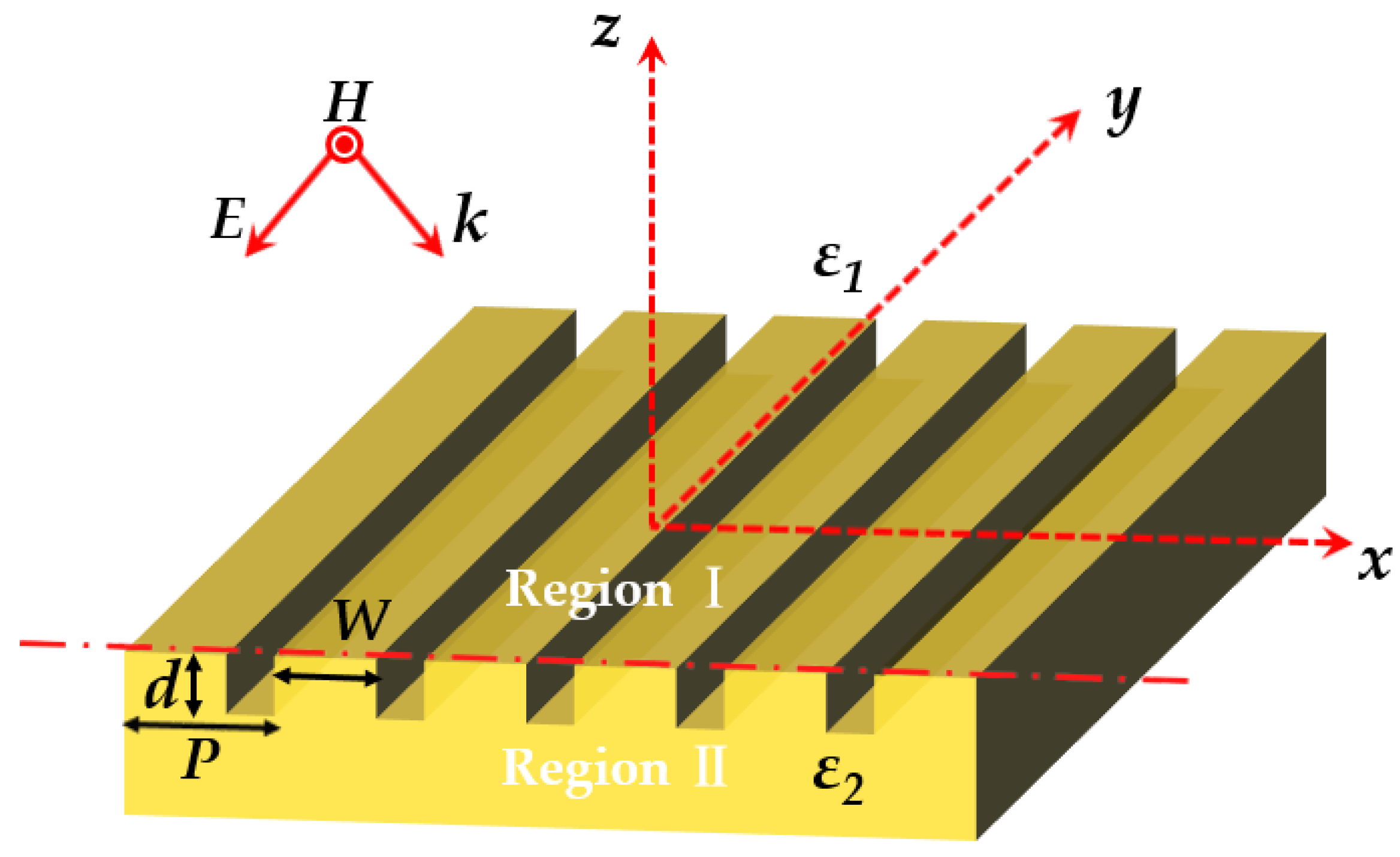
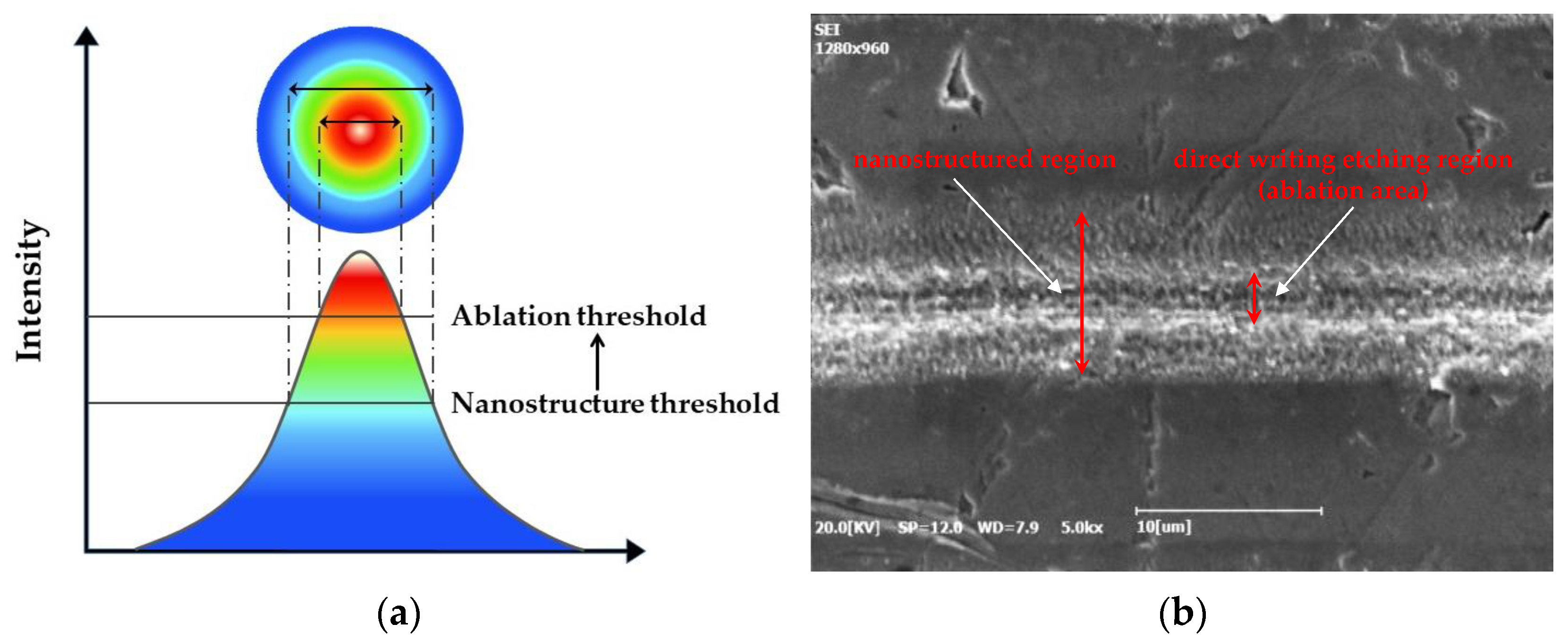
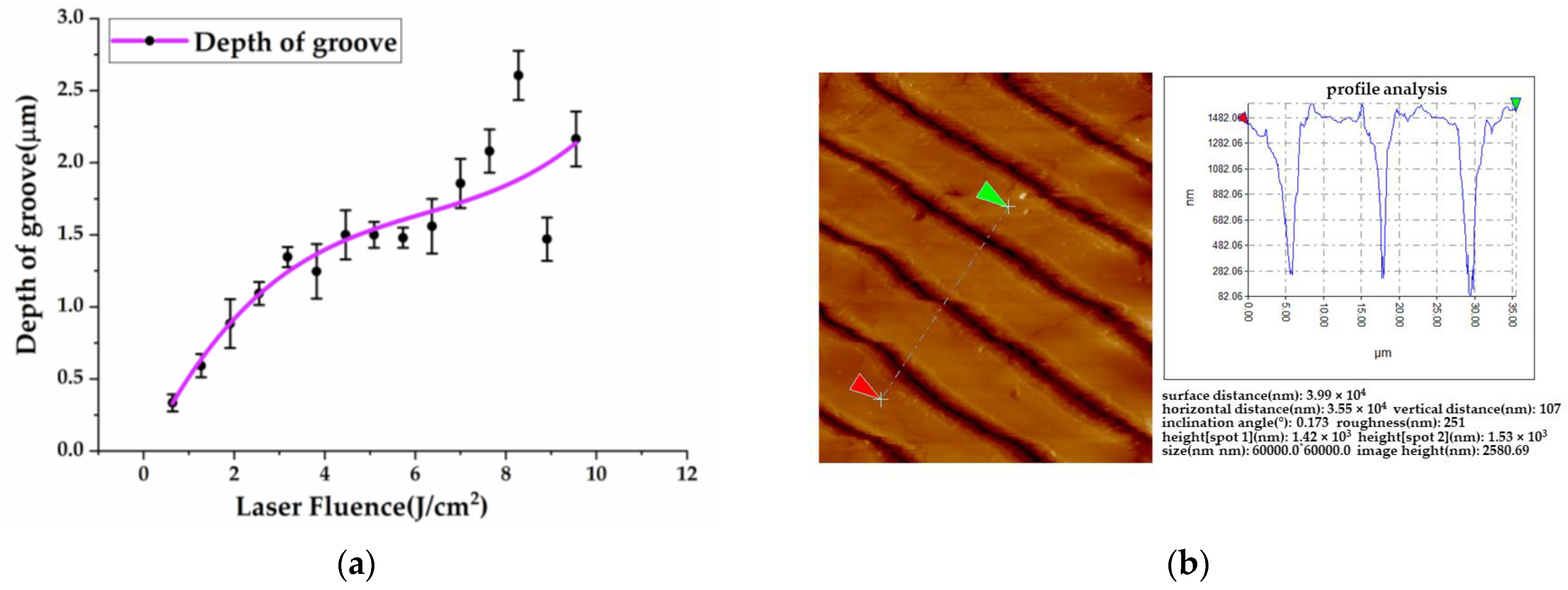


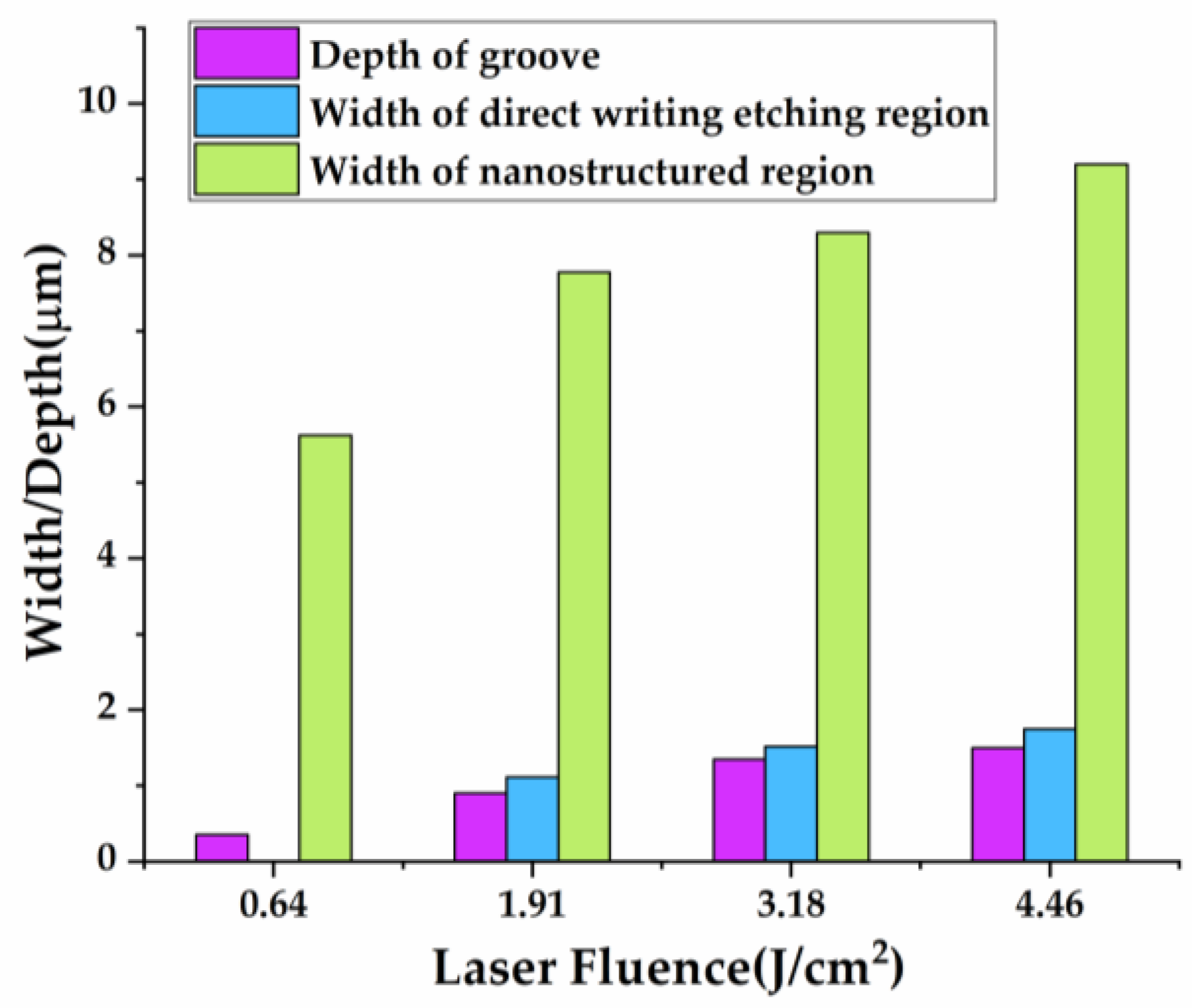
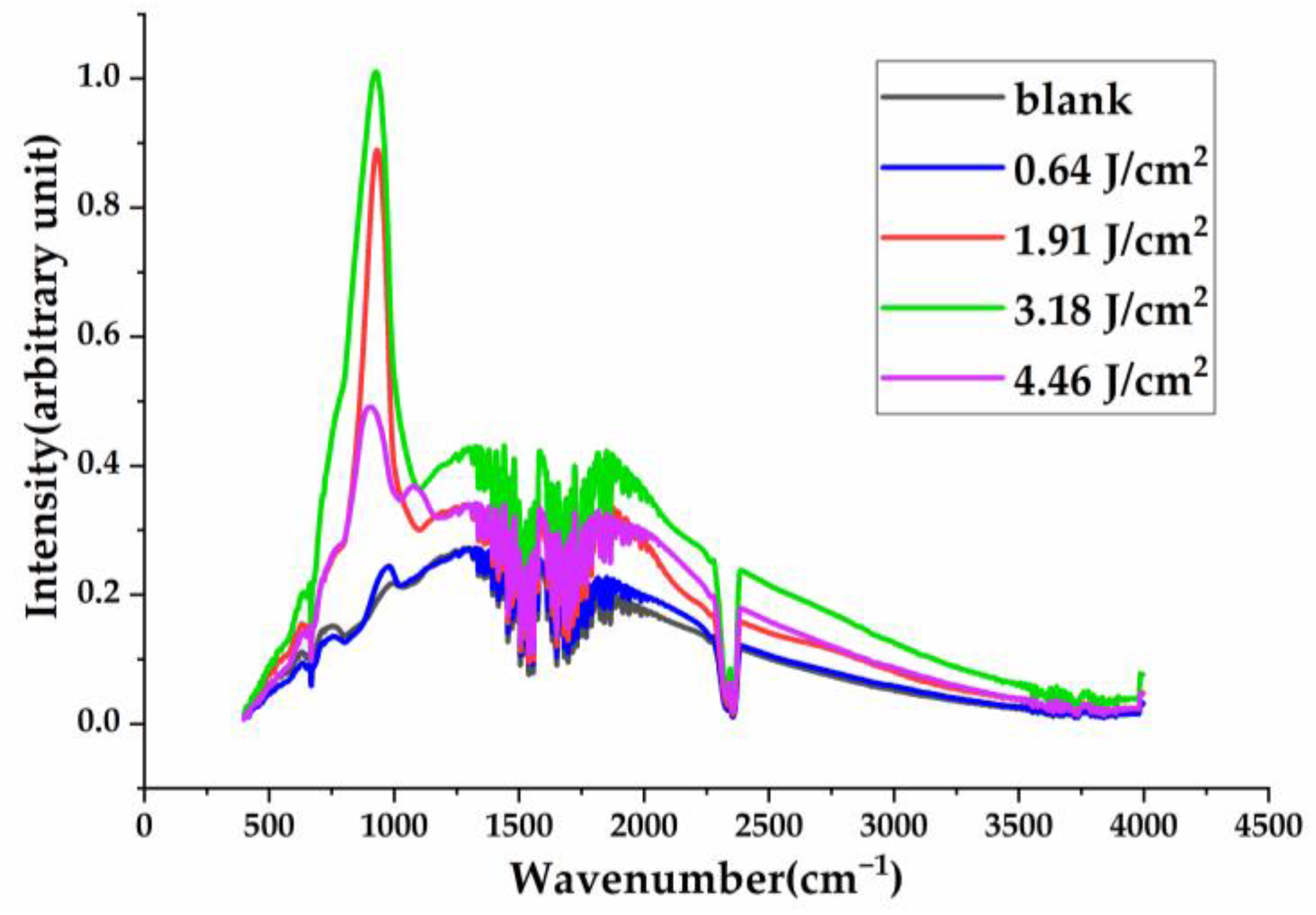


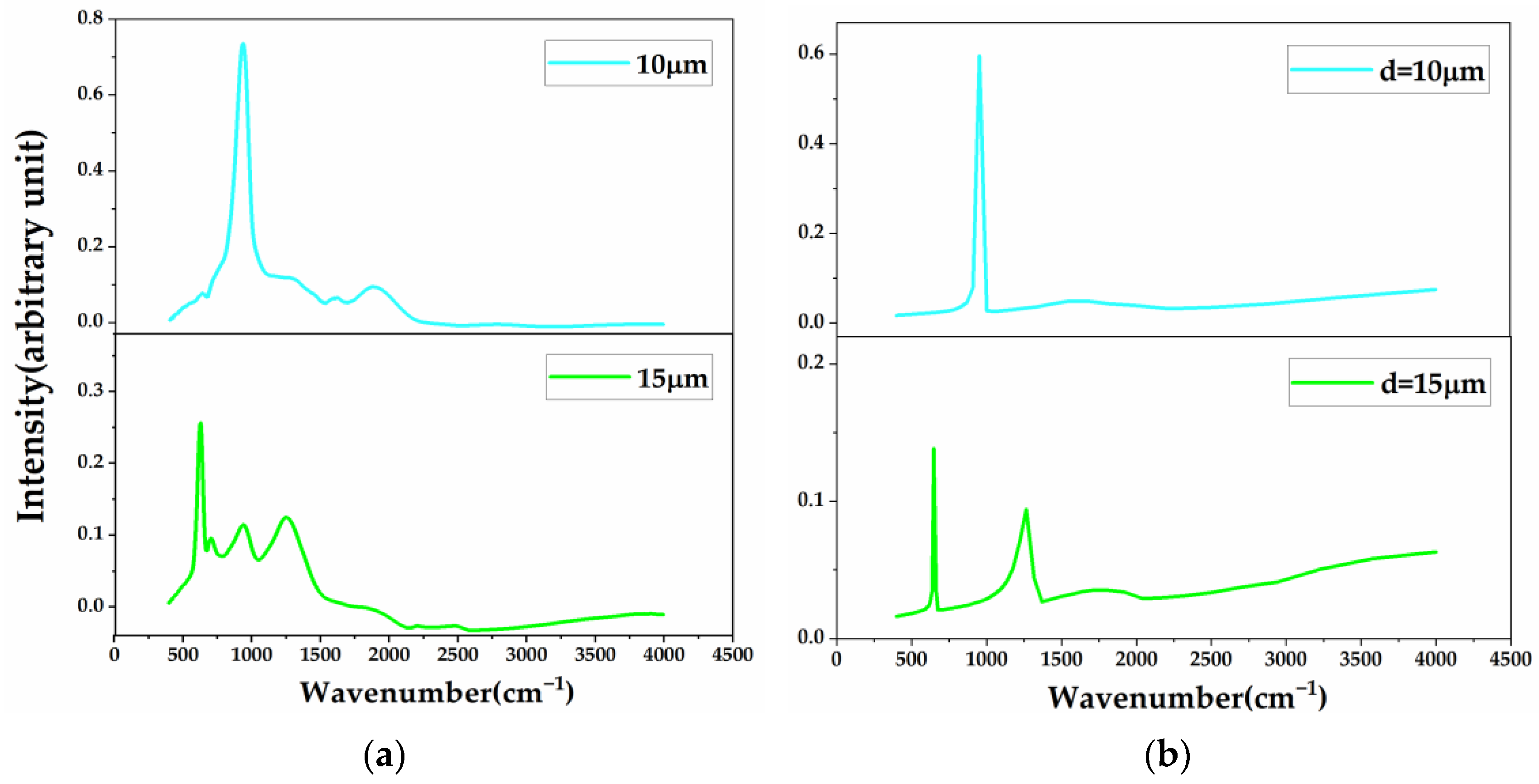
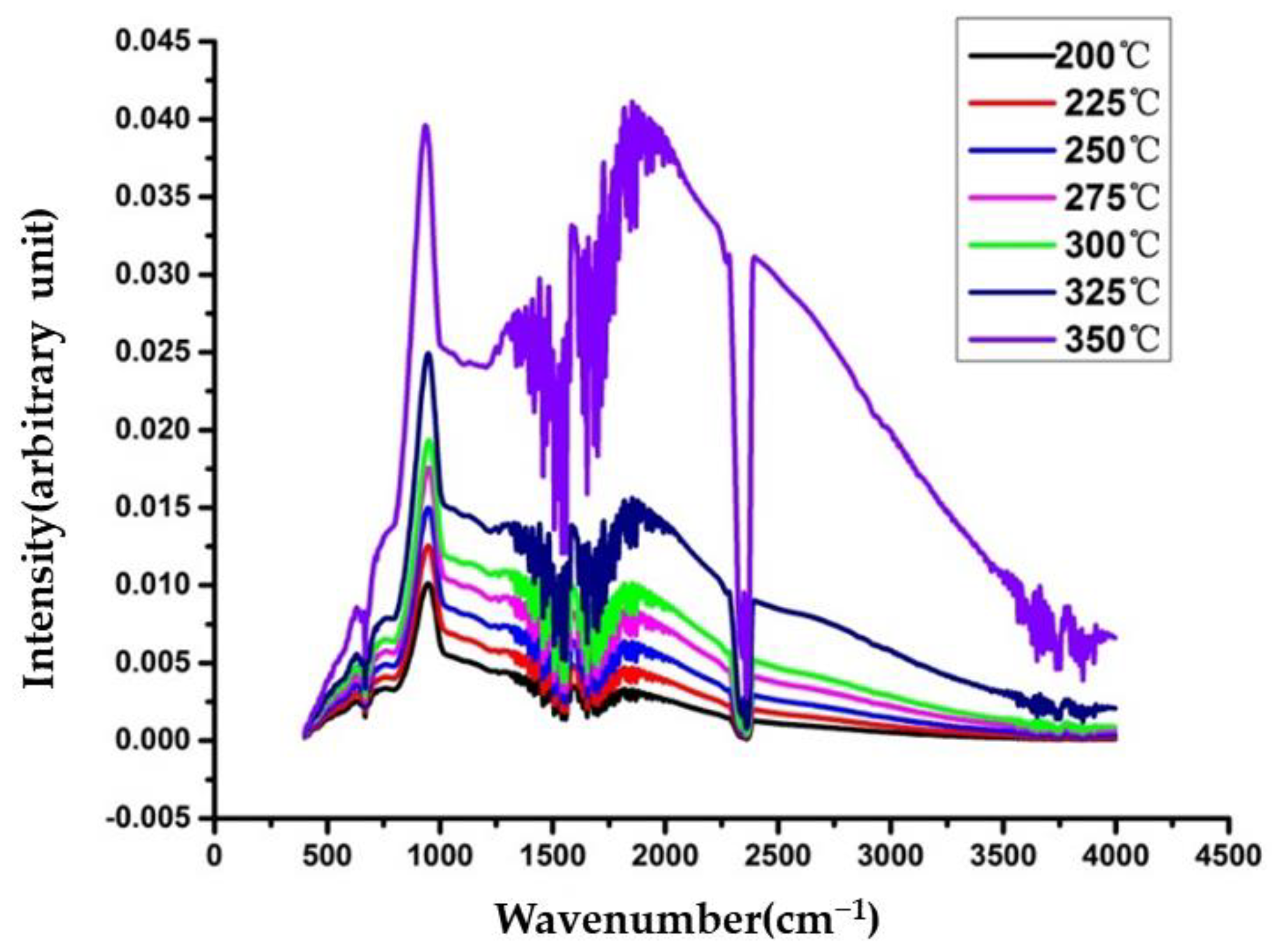
Disclaimer/Publisher’s Note: The statements, opinions and data contained in all publications are solely those of the individual author(s) and contributor(s) and not of MDPI and/or the editor(s). MDPI and/or the editor(s) disclaim responsibility for any injury to people or property resulting from any ideas, methods, instructions or products referred to in the content. |
© 2024 by the authors. Licensee MDPI, Basel, Switzerland. This article is an open access article distributed under the terms and conditions of the Creative Commons Attribution (CC BY) license (https://creativecommons.org/licenses/by/4.0/).
Share and Cite
Guo, R.; Zhou, P.; Zhang, W.; Song, H.; Liu, S. Study on the Thermal Radiation Characteristics of Tungsten Surface Grating Structures Prepared by Femtosecond Laser Direct Writing. Coatings 2024, 14, 1045. https://doi.org/10.3390/coatings14081045
Guo R, Zhou P, Zhang W, Song H, Liu S. Study on the Thermal Radiation Characteristics of Tungsten Surface Grating Structures Prepared by Femtosecond Laser Direct Writing. Coatings. 2024; 14(8):1045. https://doi.org/10.3390/coatings14081045
Chicago/Turabian StyleGuo, Ruxue, Ping Zhou, Wanyun Zhang, Haiying Song, and Shibing Liu. 2024. "Study on the Thermal Radiation Characteristics of Tungsten Surface Grating Structures Prepared by Femtosecond Laser Direct Writing" Coatings 14, no. 8: 1045. https://doi.org/10.3390/coatings14081045




